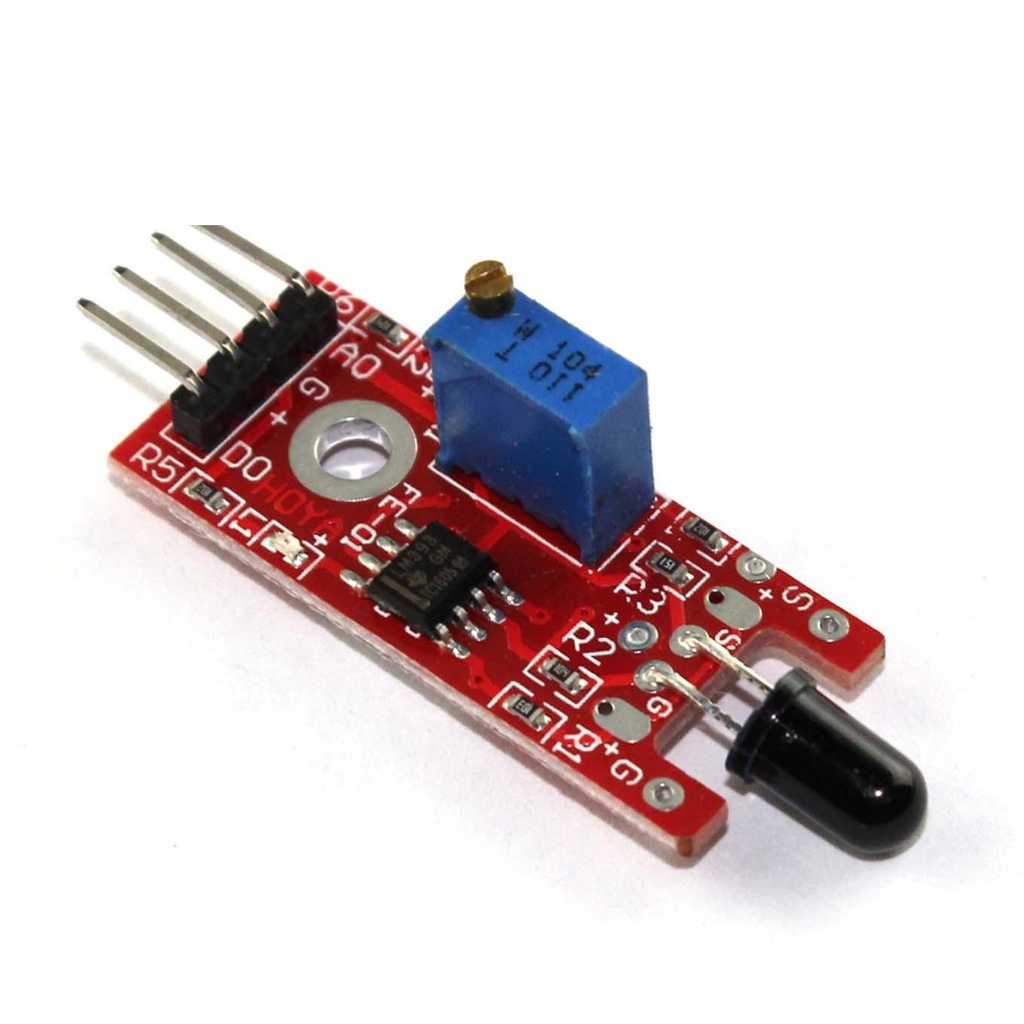Specifications
- Operating Voltage: This module operates effectively within a voltage range of 3.3V to 5.5V, providing flexibility in power supply options.
- Infrared Wavelength Detection: It is highly sensitive to infrared wavelengths in the range of 760nm to 1100nm, ensuring precise flame detection.
- Sensor Detection Angle: The sensor offers a wide detection angle of 60 degrees, enhancing its ability to cover a broad area.
- Board Dimensions: Compact in size, the board measures 1.5cm x 3.6cm (0.6in x 1.4in), allowing for easy integration into various projects.
Connection Diagram
To connect the KY-026 Flame Sensor module to an Arduino, follow these simple steps:
- Connect the board's analog output (A0) to pin A0 on the Arduino.
- Connect the digital output (D0) to pin 2 on the Arduino.
- Ensure a power connection by connecting the power line (+) to 5V and the ground (G) to GND on the Arduino.

KY-026 Arduino Code
The provided Arduino code facilitates the interaction with the KY-026 Flame Sensor module. It reads values from both the digital and analog interfaces, responding to the presence of fire or flames. Key features of the code include:
- The digital interface signals fire detection with a HIGH output, illuminating the Arduino's LED (pin 13). The potentiometer adjusts the detection threshold.
- The analog interface provides numeric values that decrease when a flame is near and rise when it moves away.
int led = 13; // Define the LED pin
int digitalPin = 2; // KY-026 digital interface
int analogPin = A0; // KY-026 analog interface
int digitalVal; // Digital readings
int analogVal; // Analog readings
void setup() {
pinMode(led, OUTPUT);
pinMode(digitalPin, INPUT);
Serial.begin(9600);
}
void loop() {
// Read the digital interface
digitalVal = digitalRead(digitalPin);
if (digitalVal == HIGH) // If flame is detected
{
digitalWrite(led, HIGH); // Turn ON Arduino's LED
} else {
digitalWrite(led, LOW); // Turn OFF Arduino's LED
}
// Read the analog interface
analogVal = analogRead(analogPin);
Serial.println(analogVal); // Print analog value to the serial monitor
delay(100);
}
Specifications
- Operating Voltage: This module operates effectively within a voltage range of 3.3V to 5.5V, providing flexibility in power supply options.
- Infrared Wavelength Detection: It is highly sensitive to infrared wavelengths in the range of 760nm to 1100nm, ensuring precise flame detection.
- Sensor Detection Angle: The sensor offers a wide detection angle of 60 degrees, enhancing its ability to cover a broad area.
- Board Dimensions: Compact in size, the board measures 1.5cm x 3.6cm (0.6in x 1.4in), allowing for easy integration into various projects.
Connection Diagram
To connect the KY-026 Flame Sensor module to an Arduino, follow these simple steps:
- Connect the board's analog output (A0) to pin A0 on the Arduino.
- Connect the digital output (D0) to pin 2 on the Arduino.
- Ensure a power connection by connecting the power line (+) to 5V and the ground (G) to GND on the Arduino.

KY-026 Arduino Code
The provided Arduino code facilitates the interaction with the KY-026 Flame Sensor module. It reads values from both the digital and analog interfaces, responding to the presence of fire or flames. Key features of the code include:
- The digital interface signals fire detection with a HIGH output, illuminating the Arduino's LED (pin 13). The potentiometer adjusts the detection threshold.
- The analog interface provides numeric values that decrease when a flame is near and rise when it moves away.
int led = 13; // Define the LED pin
int digitalPin = 2; // KY-026 digital interface
int analogPin = A0; // KY-026 analog interface
int digitalVal; // Digital readings
int analogVal; // Analog readings
void setup() {
pinMode(led, OUTPUT);
pinMode(digitalPin, INPUT);
Serial.begin(9600);
}
void loop() {
// Read the digital interface
digitalVal = digitalRead(digitalPin);
if (digitalVal == HIGH) // If flame is detected
{
digitalWrite(led, HIGH); // Turn ON Arduino's LED
} else {
digitalWrite(led, LOW); // Turn OFF Arduino's LED
}
// Read the analog interface
analogVal = analogRead(analogPin);
Serial.println(analogVal); // Print analog value to the serial monitor
delay(100);
}

